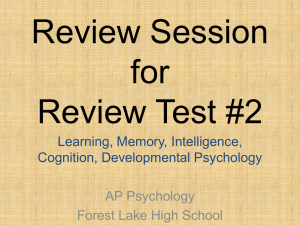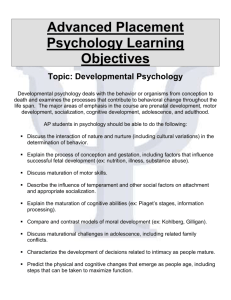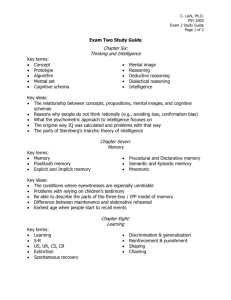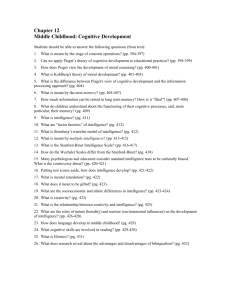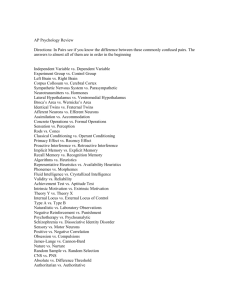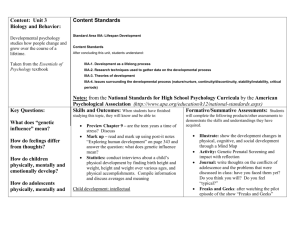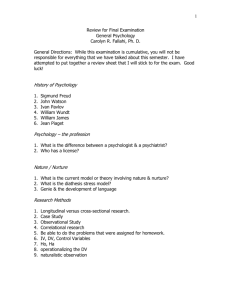Review Session for Review Test #1
advertisement
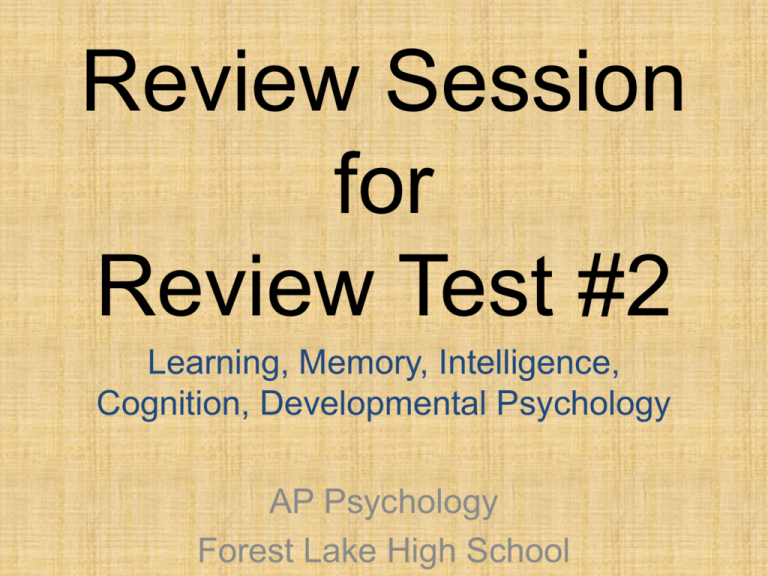
Review Session for Review Test #2 Learning, Memory, Intelligence, Cognition, Developmental Psychology AP Psychology Forest Lake High School Learning- Question #1 Young animals learn many behaviors from watching their mothers and imitating those behaviors. This kind of learning is known as… A.Instinctive learning B.Classical conditioning C.Instrumental learning D.Modeling E.Reproductive conditioning D– Modeling is another name for observational learning. Modeling involves exactly what is described in the question- watching another member of ones species perform a behavior and then attempting to copy it. Learning- Question #2 Ali became sick with the stomach flu shortly after eating a piece of fried eggplant at a party. Since then, Ali has avoided friend egg plant. What likely explains the rapid acquisition of this behavior? A. People have to develop a taste for eggplant B. Given the current emphasis on healthy food, many people are trying to reduce their consumption of fried foods. C. It is easier to develop an aversion to vegetables than to meat D. People are biologically predisposed to link unfamiliar tastes with nausea. E. Because the result of eating the eggplant was unpleasant, it is easy to learn to avoid it. D – Research has indicated that people and animals seem predisposed to link certain types of stimuli with certain kinds of consequences. As shown by Garcia and Koelling, novel tastes are easily associated with nausea but not with electric shock while loud noises and flashes of light are more easily associated with shock than with nausea. Learning- Question #3 Alfred’s sister Rosie is very serious when she practices her cello and often yells at him for interrupting her, which makes Alfred feel nervous. Alfred has recently started exhibiting signs of anxiety whenever he hears any string instrument. This situation best illustrates.. A.Generalization B.Instinctive drift C.Spontaneous recovery D.Secondary conditioning E.A biological predisposition A – Alfred has generalized his anxiety to the sound of his sister practicing cello to the sound of any string instrument. Generalization in this classical conditioning example is when on exhibits a conditioned response to stimuli that are similar, but not identical to the conditioned stimulus. In this case, the conditioned stimulus is the sound of his sister playing cello, and the response of fear or anxiety has generalized to occur to similar sounds. Learning- Question #4 Mr. Cohen wants to encourage his kids to clean up their rooms. Every time they do so, he takes them out for dinner. As time goes on, Mr. Simpson’s children clean their rooms increasingly less frequently. What does this situation demonstrate? A.The Premack Principle B.Latent learning C.Higher-order conditioning D.Discrimination E.Observational learning A – The Premack Principle essentially explains that one person’s reinforce may be another person’s punishment. While Mr. Simpson may view taking his children out for dinner as a treat for them, they may not see it the same way. Reinforcers and punishments are defined by the effects they have on behavior. Given that taking his kids out to dinner results in less of the desired behavior, that consequence is defined as a punishment. Learning- Question #5 Which of the following is the best example of negative reinforcement? A. A teacher praises a child for answering a question in class. B. A teacher keeps a student from recess after she has been disruptive during a lesson. C. A teacher brings bagels to celebrate Valentine’s Day. D. A teacher has a student wash all the classroom desks after he is caught writing on his desk. E. A teacher cancels a homework assignment after the whole class scores well on a test. E – Negative reinforcement is when something aversive (in this case a homework assignment) is removed in order to reinforce desired behavior (the strong performance on the test). A common mistake is to assume that the negative in negative reinforcement refers to punishment- the addition of something aversive. However, the definition of a reinforcer is something that makes a behavior more common: thus, the negative in this case refers to fact that the behavior is being reinforced through the removal of something unpleasant (negative reinforcement) as opposed to the addition of something pleasant (positive reinforcement). Learning- Question #6 Mr. Lopez wants his kindergarten students to come into class and go directly to the seats. Which type of reinforcement schedule would likely yield the most rapid acquisition of this new behavior? A. Fixed Ratio B. Fixed Interval C. Variable Ratio D. Variable Interval E. Continuous Reinforcement E - Typically, continuous reinforcement is most effective in teaching a new behavior because the consistent association of the reinforcer with the behavior will make the link easiest to learn. While a fixed ratio schedule of FR-1 would be equivalent to continuous reinforcement, the term fixed ratio is usually employed to refer to the practice of rewarding every x behaviors, where x is a larger number than 1. Learning- Question #7 At Central High School they ring a bell to end every class period. Sometimes, by mistake, they ring the bell in the middle of a class period and teachers find that many of their students get up to leave not realizing that only about half of the class time has gone by. The students have learned this behavior via A. Operant Conditioning B. Classical Conditioning C. Insight Learning D. Abstract Learning E. Observational Learning B - The ringing of the bell is a conditioned stimulus associated with the unconditioned stimulus of being dismissed from class. Leaving class is both the conditioned and unconditioned response. Learning- Question #8 Rescorla’s contingency model of classical conditioning modifies Pavlov’s original model by A. Describing the role of natural, inherent predispositions in facilitating certain connections B. Creating a standard apparatus in which to test the law of effect C. Suggesting the role of cognition in influencing how well a response is learned D. Showing how learning can occur in the absence of reinforcement E. Predicting a particular curve for spontaneous recovery C – Rescorla’s contingency model theorizes that learning will happen more quickly and effectively when a conditioned stimulus (CS) reliably predicts an unconditioned stimulus (US). This idea builds upon Pavlov’s contiguity model which proposed that conditioning was typically linked to the number of times a CS was paired with a US. Rescorta suggested that given the same number of pairings, acquisition would occur more quickly in the absence of additional presentations of the CS and/or US which would weaken the cognitive connection the learner would establish between the two. Learning -Question #9 A researcher investigating the effectiveness of different methods of memorizing lists is likely to be most interested in which of the following memory concepts? A.Implicit memory B.State-dependent memory C.Long-Term potentiation D.Linguistic Relativity Hypothesis E.Serial Position Effect E. The serial position effect describes the impact of the position of items on a list on recall. Items early in the list are likely to be remembered (primacy effect) and items last on a list or likely to be remembered (recency effect). Cognition- Question #10 Why are recognition tasks usually easier than recall tasks? A.Memories retrieved through recognition are stored in long term memory which is easier to access B.Recognition involves more recent memories, while recall involves events that occurred father in the past C.The process of recognition involves matching an event to something already stored in memory D.The recall process takes place in more primitive, basic areas of the brain E.The recognition process relies on sensory memory, which quickly encodes sensory stimuli we encounter C - Recognition involves matching current stimuli to what we already have stored in memory, which is an easier process than recall. Cognition- Question #11 Which of the following two memory-related concepts are most similar? A.Chunking and syntax B.Mood-congruent and state-dependent memory C.Prototypes and rehearsal D.Primacy effect and relearning effect E.Belief bias and availability heuristic B - Both mood-congruent and state dependent memory describe similar phenomena that impact the probability a memory will be recalled. Cognition- Question #12 In the information processing model, encoding takes place between which steps in the model? A.Between semantic and episodic, and between episodic and procedural B.Between sensory and short term, and between short term and long term C.Between retrieval and recognition, and between recognition and recall D.Between retroactive and proactive, and between proactive and interference E.Between convergent and divergent, and between divergent and heuristic B- The three box model consists of sensory, short term, and long term memory. Memories are encoded from sensory to short term memory and from short term to long term memory. Cognition- Question #13 Children who do not learn a primary language before adolescence typically have trouble becoming fluent in ant language during the rest of their lives. This research finding most supports which theory of language acquisition? A. Overgeneralization B. Linguistic relativity hypothesis C. Semantic network hypothesis D. Nativist theory E. Divergent thinking D - The nativist theory of language acquisition predicts that there is a critical period of maturation during which human brains are “wired” to acquire language. If a child passes through this critical period without acquiring language, it will be difficult for that child to ever acquire language. Cognition- Question #14 Wolfgang Kohler’s research involving problem solving and primates provided valuable empirical evidence supporting which cognitive concept? A.Divergent thinking B.Prototypes C.Representativeness heuristic D.Algorithms E.Eidetic memory A- Evidence from Kohler’s studies support the idea that divergent thinking can occur in non-human primates (such as chimpanzees) and that divergent thinking involves steps such as experimentation and reflection. Cognition- Question #15 Which of the following terms is most likely to be used by biopsychologists when discussion how memories are stored? A.Sensory memory B.Long-term potentiation C.Availability heuristic D.Functional fixedness E.Information-Processing Model B – Long-Term Potentiation is the process of the strengthening of neural connections which bio-psychologists theorize result in the phenomenon of memory! Testing & Individual Difference Question #16 What is the best definition of a standardized sample? A. B. C. D. E. A group of average people who perform at or above a reasonable level on an exam. People who achieve at a similar level each time a test is administered. A set of people whose performance on a set of questions is used to create a test of a desired difficulty level. The psychometricians who create a test that can be used to compare people across many different backgrounds and experiences. The statisticians who developed the normal curve such that tests can be standardized. C - Ideally, the standardization sample is a group of people similar to the people who will take an actual exam. Because the results of a standardized test are supposed to result in a normal distribution, test makers have to have a good sense of what percentage of people will get each item right. Testing & Individual Difference Question #17 Whose theory of intelligence most directly incorporates a sense of “street smarts”? A.Sternberg B.Goleman C.Gardner D.Spearman E.Flynn A – Sternberg’s Triarchic theory of intelligence includes a traditional academic type of intelligence (known as componential or analytic intelligence), experiential or creative intelligence that depends on one’s ability to use knowledge in new ways, and a type of contextual or practical intelligence that enables people to apply what they know to real-world challenges. The concept of practical intelligence is related to street smarts. Testing & Individual Difference Question #18 Cornelius is an average student but a gifted dancer and gymnast. He is well-liked and gets along well with most people. Based on this information, we can conclude that Cornelius has a lot of what types of intelligence? A.Intrapersonal and Naturalistic B.Contextual and Interpersonal C.Kinesthetic and Musical D.Interpersonal and Kinesthetic E.Practical and Musical D – Given Cornelius’ talent as a dancer and gymnast, we can conclude that he has what Gardner terms bodily kinesthetic intelligence. He also seems to possess a high level of interpersonal intelligence, based on the remarks about his ability to get along with others. On the other hand, we are not given any information that bears on Cornelius’ intrapersonal skills (his knowledge about himself), his naturalistic intelligence (his intelligence about the environment), nor his musical intelligence. While all of the aforementioned types of intelligences are part of Gardner’s theory of multiple intelligences, Sternberg’s triarchic theory of intelligence deals with other types of intelligence including practical and contextual; however, the information in the question does not tell us anything about Cornelius’ strengths in these arenas. Testing & Individual Difference Question #19 SAT I scores have a correlation of about .5 with first year grades in college but no clear relationship to performance in college or career overall. From this information, one can conclude that the SAT A. B. C. D. E. Is an unreliable measure of intelligence Is a valid measure of intelligence Has high concurrent validity Has moderate concurrent validity Should be weighed more heavily in the college admission process D – A correlation of .5 is considered a moderate correlation. Seeing that SAT I scores moderately predict people’s first year performance in college, they can be said to have moderate predictive validity, albeit short-lived. This correlation does not mean that the SAT is (or is not) a measure of intelligence. The existing correlation also does not tell us anything about the exam’s concurrent validity – that is, its correlation with current performance. Finally, most people consider this statistic to be an indication that the SAT I should count less (rather than more) in the college admissions process. Testing & Individual Differnce Question #20 Someone who scores two standard deviations above the mean on a standardized exam scored closest to which percentile A.84th B.90th C.95th D.97th E.99th D – Someone who scores two standard deviations above the mean scores at approximately the 97.5 percentile. Someone who scores at the mean, scores at the 50th percentile. One standard deviation above the mean adds about another 34% and the second standard deviation above the mean adds about another 13.5 %; added together, these equal approximately 97.5%. The most common error here is to choose the 95th percentile as 95% of scores in a distribution fall within two standard deviations of the mean; that, however, does not include the approximately 2.5% of scores that fall below two standard deviations of the mean. Developmental Psychology Question #21 Mary Ainsworth’s research into children’s reactions to the strange situation is most directly connected to what other set of research studies? A. Baumrind’s research about parenting styles B. Kohlberg’s research about moral development C. Freud’s research about unconscious development D. Harlow’s research about attachment development E. Erikson’s research about social development D. Harlow researched attachment in primates, and Ainsworth’s later research with the strange situation investigated how different kinds of attachment between human babies and caregivers. Developmental Psychology Question #22 Why might a researcher choose to do a cross-sectional study rather than a longitudinal study? A. Cross-Sectional Studies can establish cause and effect, while longitudinal studies can only establish correlation B. Following one group of individuals over time in a longitudinal study isn’t a method as examining multiple groups at the same time in a cross-sectional study. C. Cross-Sectional Studies are a less time consuming way to examine the possible impacts of maturation. D. Longitudinal studies usually are not approved by university ethics review boards. E. Cross-Sectional Studies were supported by developmental stage theorists, such as Jean Piaget. C. Cross sectional studies are less time consuming than longitudinal studies, which involve studying one group of people over a long arc of time. Developmental Psychology Question #23 Which developmental stage theorist is most closely associated with Freud? A.Piaget B.Kohlberg C.Erikson D.Baumrind E.Binet C. Erikson’s social development theory expands on Freud’s theory of unconscious conflicts and desires. Erikson was a neo-Freudian who believed that we mature through stages of social development, and he theorized that the unconscious beliefs and attitudes we develop during early stages (even infancy) influence our later social development and behaviors. Developmental Psychology Question #24 Which of the following is a prenatal environmental influence that impacts human development? A. Teratogens B. Assimilation C. Accommodation D. Egocentrism E. Attachment A. Teratogens are chemicals that can harm a developing fetus if ingested or contracted by the mother. Developmental Psychology Question #25 Modern developmental psychology research indicates that which of the following aspects of Piaget’s original cognitive development theory were inaccurate? A.Human cognitive development does not progress in predictable stages. B.Object permanence does not develop until later cognitive development stages. C.Accommodation processes occur instead of assimilation processes within the context of cognitive development. D.Cognitive development may progress in a more continual way than the discrete stages described by Piaget. E.Genetic influences may drive the sequence and speed fo cognitive development, rather than environmental influences. D. Modern developmental psychologists criticize Piaget’s original cognitive development theory for emphasizing discrete stages, rather than a more gradual and continual cognitive development. Developmental Psychology Question #26 Five year old Sjoen seems fascinated by the different characteristics of his toy cars. He spends hours rearranging them by size, color, speed, and other physical characteristics. As he gets older, he uses increasingly complex rules to group the cars into different categories. Which developmental theorist would be most interested in this example of development? A.Erik Erikson B.Jean Piaget C.Mary Ainsworth D.Diana Baumrind E.Carol Gilligan B. A cognitive development theorist like Piaget would be most interested in this example of concept formation. As Sjoen creates new ways to categorize his cars, he is developing new schemes for these existing toys, assimilating and accommodating his experiences. Developmental Psychology Question #27 Which of the following elements of maturation is least affected by environmental influences? A. Attachment B. Motor Development C. Concepts of Conservation D. Assimilation E. Cognitive Development B. Motor development progresses through a series of predictable stages based on muscle and coordination development, and is not strongly impacted by environmental influences. Developmental Psychology Question #28 Writing a science fiction story about the potential applications of a time travel device requires thinking typical of which cognitive stage of development as described by Piaget? A. Sensorimotor Stage B. Formal Operational Stage C. Preoperational Stage D. Generativity vs. Stagnation Stage E. Divergent Thinking Stage B. Writing about the possibilities of time travel requires abstract and hypothetical thinking, which are aspects of the formal operational stage as described by Piaget. Memory Question #29 Compulsive gamblers frequently recall losing less money than is actually the case. Their memory failure best illustrates: A. Serial Position Effect B. Next-In-Line Effect C. Motivated Forgetting D. Source Amnesia E. Proactive Interference C – Motivated forgetting is a concept that arose in early theories of psychology, and many might better associate it with repressed memories. The essential idea is that the ability to recall a memory may be influenced by feelings, by a need to protect the self, or by distorted perception. Freud suggested that people frequently have imperfect or no memory recall of traumatic events or of things associated with unpleasant feelings. For example, a person is highly motivated to forget a doctor’s appointment if he fears the doctor. Memory Question #30 The next-in-line effect best illustrates: A. Long-Term Potentiation B. Source Amnesia C.Encoding Failure D.Automatic Processing E. Implicit Memory C – When you are so anxious about being “next-in-line” that you fail to remember what the person just before you has said (no STM or LTM), but you can remember what other people around you said in terms of “sensory (echoic) memory”. Memory Question #31 You witnessed a murder. Weeks later, you are called to view a police line up in which you are to pick out the murderer from a line up. Later you are called to the witness chair during the trial to tell what you saw. In the police lineup, you are using _______ while in the trial you are using ________. A.Recognition, Recall B.Recognition, Relearning C.Relearning, Recall D.Recall, Recognition E.Relearning, Recognition A – Recognition is how you respond to a sensory cue. You look at something and your mind looks to see if what you are seeing in front of you matches anything that has been stored. If you notice a match, you are recognizing the information. VS. Recall is a way that you obtain information from your memory without having a cue to prompt the response. You have to essentially draft the information without any assistance. Memory Question #32 Which of the following sequences represents progressively deeper levels of processing? A. Functional, Structural, Semantic B. Semantic, Phonemic, Structural C. Structural, Semantic, Phonemic D. Phonemic, Semantic, Structural E. Structural, Phonemic, Semantic E – Two forms of shallow processing: Structural (appearance/”looks like”) which is when we encode only the physical appearance of something (e.g. the typeface of a word or how letters look) and Phonemic (“sounds like”) which is when we encode the way the word sounds. Deep Processing: Semantic (meaning)which is when we encode the meaning of a word and make connections to words with similar meaning.
